
Lot 139
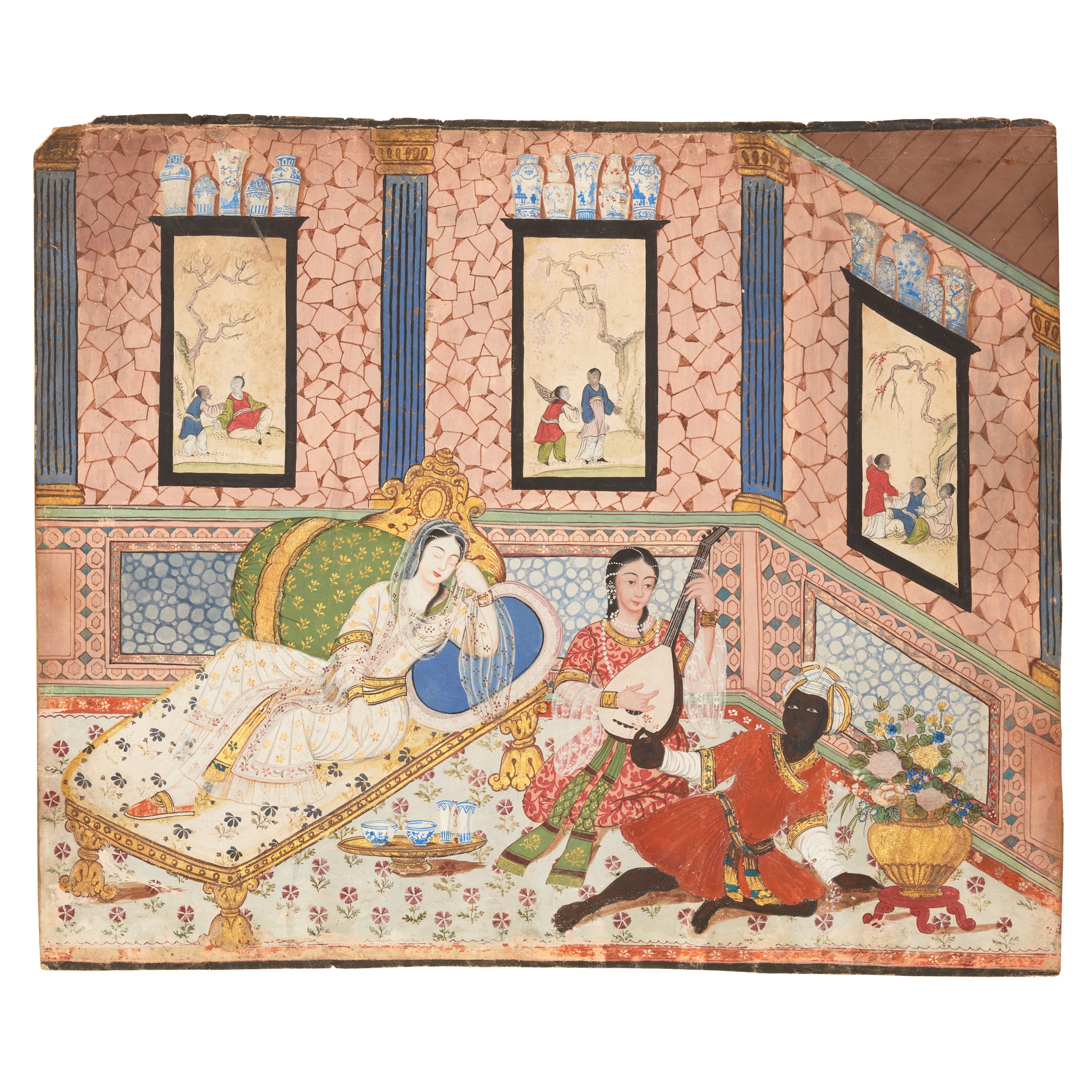
A EUROPEAN MISTRESS RESTING ON HER DIVAN LISTENING TO A FEMALE MUSICIAN PLAYING THE LUTE WITH AN AFRICAN YOUTH STRETCHED LOUNGING BEFORE THEM IN THE FOREGROUND
INDIA, GUJARAT, SURAT, CIRCA 1740
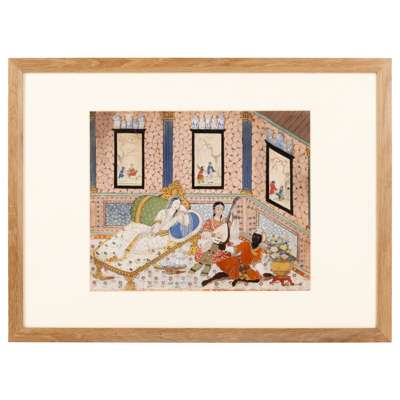
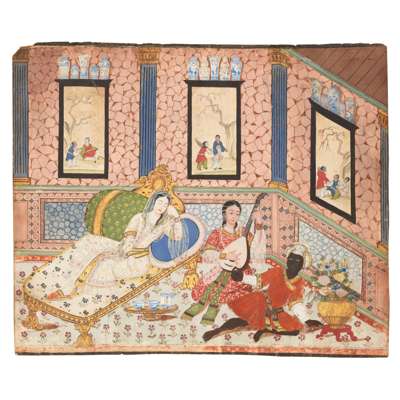


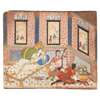
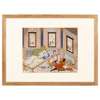
Auction: Indian Paintings from the Collection of William & Mildred Archer | Lots 84 to 152 | 12 June at 10am
Description
gouache on paper heightened with gold, dark blue border, depicting a corner interior, the pink stone patterned walls decorated with three Chinese paintings within black frames, Chinese blue and white porcelain vessels sitting above them, three dark blue neo-Classical columns, the dadoes decorated with blue marble niches, the European mistress is robed in white with gold patterned sprigs and gold trimmings and lies on her carved and gilt wood divan with her eyes closed against a green bolster, her female companion is dressed in red with gold trimmings and is playing the lute, whilst an African youth in a red dress is lounging beside her by a pot of flowers and offering sprigs of roses, verso inscribed in pencil with ‘?1830’ and ‘coso’, mounted, glazed and framed
Dimensions
Folio: 29.2cm x 34.8cm (11½in x 1 6/8in).
Provenance
Acquired before 1967.
Footnote
Exhibited:
Loan to Bristol Museum and Art Gallery, from 1994 to 2004, no. 89.
Literature:
Andrew Topsfield, 'Ketelaar's embassy and the farangi theme in the art of Udaipur', Oriental Art, XXX, 4, Winter 1984-85, pp. 350-67, Fig. 19.
This remarkable and unique painting with its strong European and Chinese influences must have intrigued and even mystified William Archer. A date on the back of the painting is tentatively written as 1830 with a question mark and the word ‘coso’. A scene springs to mind of the Archers laying down the painting on their living room floor and inviting their close knit circle of scholars and friends to discuss the attribution at their home in North London.
When the painting was on loan to Bristol Museum and Art Gallery from 1994 to 2004, the attribution given was Surat, Gujarat, circa 1740, following an article that Dr. Andrew Topsfield wrote in 1984, op.cit.
To support this attribution, it is important to explore Surat as a central trading post and to study the painting’s pictorial qualities.
The city of Surat is situated in the state of Gujarat, overlooking the estuary of the river Tapti flowing into the Arabian Sea. The Portuguese arriving in 1507 recognised the importance of Surat as a seaport. The city was the most prosperous port in the Mughal Empire and it is likely that Sir Thomas Roe disembarked here when he arrived in India in 1616 as an ambassador to the court of the Mughal emperor Jahangir at Agra where he remained for three years. Roe arrived with letters from James I eager to gain protection for the East India Company based at Surat.
During the 18th century, Gujarat saw the emergence of Ram Singh the great navigator and architect, who was famously stranded in Holland for 18 years. When he finally returned to Gujarat, he brought back with him a curiosity for the fashion and delights of Europe, which would no doubt have impacted the curiosity of local artists.
Surat was well positioned to receive Arab sea-fairing traders travelling with commodities such as porcelain vases from far off China as pictured. Chinese glass paintings were traded, as was gold, cloth and jewels. Shipbuilding Surat today is the leading centre for diamond manufacture.
Fine Chinese porcelain has always been much in demand across Europe and Asia and the Muslim rulers of the Mughal, Safavid and Ottoman courts were all keen collectors. The Mughal emperor Babur (r.1526-1530) had a purpose-built hall for an exhibition of Ming porcelain and his great-grandson Jahangir (r. 1605-1627) often showed pieces in the alcoves of his palace chambers. This scene, although a century later, reflects this appreciation of Chinese porcelain and Surat would have been an easy port of entry into the Indian sub-continent for traders of such pieces.
Africans are not common subjects in Indian painting rendering this painting rare. The youth pictured here is particularly well dressed with a red jama and a white turban decorated with an aigrette. But it is his relaxed manner and pose lounging before his mistress that intrigues the viewer. Sidhus or Africans came in great numbers from the East coast of Africa to the courts of India. Clearly this young African is a favourite as indicated by his manner.
The painting draws on a rather awkward corner interior scene. It appears that the artist has not quite understood perspective, something that Kutch artists mastered better in the 19th century. It is well documented that a sizeable group of 18th century European prints arrived in Gujarat , setting about a hive of activity amongst the local artists (see, B. N. Goswamy and A. L. Dallapiccola, A Place Apart: Painting in Kutch, 1720-1820, Delhi, 1983, p.33). The painting has a narrow black border which is characteristic of these European-influenced paintings. For further examples with the narrow black border, see op. cit, plate XX, figures 19, 24 to 35.
In summary, not only was the artist influenced by European prints that were readily available but equally by the prosperous world around him, freely interpreting it with his own imagination. In this case, the artist has created a rather charming pastiche.
For another painting, originally in the Edith and Stuart Cary Welch Collection, that shares similar characteristics in terms of the ‘pastiche’-style and the black border, see Sotheby’s, 25th October 2023, lot 47.





